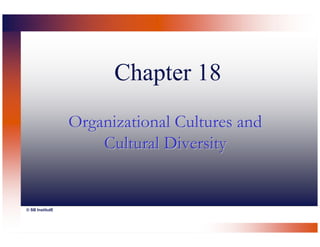
Ch18
- 1. Chapter 18 Organizational Cultures and Cultural Diversity © SB InstitutE
- 2. 18.1 Learning Objectives After reading this chapter, you should be able to: • Describe the core elements of a culture • Compare and contrast four types of organizational culture • Discuss several types of subculture that may exist in organizations • Explain why managing cultural diversity is important and describe several activities required to manage it successfully © SB InstituE
- 3. 18.2 The Culture Iceberg •Practices Observable •Narratives Elements of •Language Culture •Symbols •Socialization Hidden •Norms Elements of Culture •Values •Assumptions © SB InstituE Adapted from Figure 18.1
- 4. 18.3 Framework of Types of Cultures Flexible Clan Entrepreneurial culture culture Formal Control Orientation Bureaucratic Market culture culture Stable Internal External Focus of Attention © SB InstituE Adapted from Figure 18.2
- 5. 18.4 Dimensions for Describing Industry Cultures Employee-oriented: Results-oriented: Concern focuses on people Concern focuses on doing the work achievement of goals Parochial: Professional: Employees identify with Employees identify with organization type of work or profession Open system: Closed system: Many types of people feel Type of person who fits is comfortable in organization narrowly specified Loose Control: Tight Control: Codes of conduct allow for Written and unwritten rules much variation among exert tight control over employees behavior © SB InstituE Adapted from Figure 18.4
- 6. 18.5 Organizational Goals for Managing Diversity Legal Compliance Creating a Creating Positive Economic Culture Value © SB InstituE
- 7. 18.6 Phases of Diversity Management Change Efforts Understanding the goals to be achieved Assessing the current organization and understanding its history Designing a strategic plan Implementing targeted change efforts Monitoring change and making adjustments © SB InstituE Adapted from Figure 18.6
- 8. 18.7 Components of Texaco’s Cultural Change Initiatives Recruitment and Hiring Identifying and Ensuring Fair Developing Treatment Talent Holding Improving Relationships managers with External accountable Stakeholders © SB InstituE Adapted from Table 18.2
